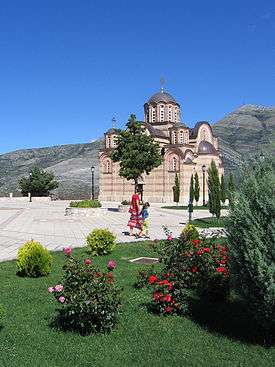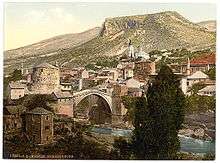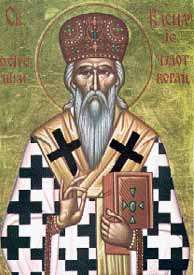Eparchy of Zahumlje and Herzegovina
| Eparchy of Zahumlje and Herzegovina | |
|---|---|
 Gračanica, in Trebinje | |
| Location | |
| Territory | Parts of Bosnia and Herzegovina, Croatia and Montenegro |
| Headquarters | Mostar, Bosnia and Herzegovina |
| Information | |
| Denomination | Eastern Orthodox |
| Sui iuris church | Serbian Orthodox Church |
| Established | 1219 |
| Language |
Church Slavonic Serbian |
| Current leadership | |
| Bishop | Grigorije Durić |
| Map | |
-en.svg.png) | |
| Website | |
| Eparchy of Zahumlje and Herzegovina | |
The Eparchy of Zahumlje, Herzegovina and the Littoral (Serbian: Епархија Захумско-херцеговачка и Приморска) is an eparchy (diocese) of the Serbian Orthodox Church with its seat in Mostar, Bosnia and Herzegovina. It has jurisdiction over the region of Herzegovina, the littoral region of southern Dalmatia in Croatia and a small part of Montenegro. Since 1999, the Bishop of Zahumlje and Herzegovina has been Grigorije Durić.
History
Ecclesiastical background
The region was under the Eastern Orthodox Metropolitanate of Dyrrachium, which in turn was under the Ecumenical Patriarchate of Constantinople. In 1089, the see of Trebinje (Travunia) was briefly theoretically under the jurisdiction of the Archbishopric of Bar.
Middle Ages
The Eparchy of Hum or Zahumlje was founded in 1219, by first Serbian Archbishop Sava, the same year the Serbian Orthodox Church acquired its autocephaly status from Patriarchate of Constantinople. Thus, it was one of the original Serbian Orthodox bishoprics. It had jurisdiction over historical regions of Zahumlje and Travunija. The first Bishop of Hum was Ilarion, succeeded by Sava II (son of Stefan the First-Crowned). The original seat was in Ston, in the church of the Most Holy Theotokos (Пресвете Богородице). Following an earthquake, the bishop moved the seat to the Monastery of Holy Apostles in the valley of river Lim in the 1250s. From that time, the Eparchy of Hum was sometimes also called "Eparchy of Lim".
With the War of Hum (1326–29), most of Zahumlje was taken over by Stephen II, Ban of Bosnia, but the Travunija region remained under the rule of Serbian Kings. After the creation of the Serbian Patriarchate of Peć in 1346, all original Serbian bishops were raised to the honorary rank of metropolitan bishops. The see of the eparchy was then moved to the Mileševa monastery. In the middle of 15th century, Metropolitan David was a very influential figure in the court of Stefan Kosača, who was titled Duke (Herzeg) of Saint Sava. Following the fall of the Duchy of St. Sava to the Ottoman Empire (1482), the see was frequently moved, finally to settle in the Tvrdoš Monastery near Trebinje in 1508. Eventually, the eparchy was further divided into the Eparchy of Mileševa.
Modern and contemporary history
In 1557, Serbian Patriarchate of Peć was restored and the Eparchy of Herzegovina was returned to its jurisdiction, with its bishops of holding the honorary title of metropolitan.[1] In 1766, when the Serbian Patriarchate of Peć was abolished, Eparchy of Herzegovina and all other Serbian eparchies under Ottoman rule came under the jurisdiction of Ecumenical Patriarchate of Constantinople. Bishops of Herzegovina kept their honorary title of Metropolitan, as was also the custom in the Ecumenical Patriarchate. The seat of metropolitan was transferred to Mostar.

Since 1878, territory of Bosnia and Herzegovina was under the occupation of Austria-Hungary, but under the Church Convention of 1880 all Eastern Orthodox eparchies remained under the ecclesiastical jurisdiction of the Ecumenical Patriarchate of Constantinople. At the end of the First World War in 1918, all Serbian Orthodox bishops in Bosnia and Herzegovina reached a unanimous decision to join with other Serbian ecclesiastical provinces into united Serbian Orthodox Church. The process of unification was completed in 1920 and since then the Eparchy of Zahumlje and Herzegovina has remained part of Serbian Orthodox Church.[2]
The seat of the eparchy was the Cathedral of the Holy Trinity, Mostar. As of 2017, it is being rebuilt after being demolished during the Bosnian War.
Heads
| Picture | Name | Time | Notes | |
|---|---|---|---|---|
| Ilarion | 1219–? | First bishop. | ||
| Metodije | ||||
| Teodosije | ||||
| Nikola | ||||
| Sava II | ?–1264 | Son of Stefan the First-Crowned. | ||
| Jevstatije | ca. 1300 | |||
| Jovan | ca. 1305 | |||
| Danilo | 1316–24 | hagiographer and Archbishop of Peć | ||
| Stefan | 1324 | moved, Eparchy of Hum also known as "Eparchy of Lim" | ||
| Metropolitan of unknown name | 1377 | Crowned Stefan Tvrtko I as King of Serbs and Bosnia. | ||
| David | 1465 | Metropolitan in the Duchy of St. Sava (Herzegovina) | ||
| Jovan | 1508–1513 | Restored Tvrdoš in 1508 (becoming the see) | ||
| Visarion | 1509–1525 | |||
| Maksim | before 1532 | |||
| Marko | 1531–1534 | |||
| Nikanor | 1534–1546 | |||
| Antonije | 1570 | |||
| Savatije Sokolović | 1573–85 | |||
| Visarion | 1590–1602 | |||
| Silvestar | 1602 | |||
| Leontije | 1605–11 | |||
| Simeon | 1613—1635 | |||
 |
Basil of Ostrog | 1639–49 | Saint | |
| Simeon Ljubibratić | 1671–1681 | |||
| Savatije Ljubibratić | 1683–1716 | Sided with Venetians during the war, styled as bishop "of Zahumlje and Dalmatia" | ||
| Nektarije | 1693–1712 | |||
| Melentije | 1712–1713 | |||
| Arsenije II | 1715 | |||
| Gerasim | 1716–1717 | |||
| Aksentije I | 1727-1736 | |||
| Filotej | 1741—1751 | |||
| Aksentije II | 1763-1766 | |||
| Stefan | 1763-1766 | |||
| Antim | 1766—1772 | |||
| Ananije | 1772—1802 | |||
| Jerimija | 1803—1815 | |||
| Josif I | 1816—1835 | |||
| Prokopije I | 1837—1838 | |||
| Aksentije III | 1838—1848 | |||
| Josif II | 1848—1854 | |||
| Grigorije | 1855—1860 | |||
| Prokopije | 1864—1875 | |||
| Ignatije | 1875—1888 | |||
 |
Leontije Radulović | 1888 | ||
 |
Serafim Perović | 1889–1903 | ||
| Petar Zimonjić | 1903–20 | |||
Monasteries
There are eight monasteries in the diocese:[3]
- Dobrićevo
- Duži
- Žitomislić
- Zavala
- Zubci
- Petropavlov
- Tvrdoš
- Hercegovačka Gračanica
See also
References
- ↑ Sotirović 2011, pp. 143-169.
- ↑ Kiminas 2009, pp. 22, 28.
- ↑ http://www.eparhija-zahumskohercegovacka.com/
Sources
- Јанковић, Марија (1985). Епископије и митрополије Српске цркве у средњем веку (Bishoprics and Metropolitanates of Serbian Church in Middle Ages). Београд: Историјски институт САНУ.
- Boris Nilević (1990). Srpska pravoslavna crkva u Bosni i Hercegovini do obnove Pećke patrijaršije 1557. godine. Veselin Masleša.
- Вуковић, Сава (1996). Српски јерарси од деветог до двадесетог века (Serbian Hierarchs from the 9th to the 20th Century). Евро, Унирекс, Каленић.
- Bataković, Dušan T. (1996). The Serbs of Bosnia & Herzegovina: History and Politics. Dialogue Association.
- Mileusnić, Slobodan (1997). Spiritual Genocide: A survey of destroyed, damaged and desecrated churches, monasteries and other church buildings during the war 1991-1995 (1997). Belgrade: Museum of the Serbian Orthodox Church.
- Popović, Svetlana (2002). "The Serbian Episcopal sees in the thirteenth century (Српска епископска седишта у XIII веку)". Старинар (51: 2001): 171–184.
- Ćirković, Sima (2004). The Serbs. Malden: Blackwell Publishing.
- Kiminas, Demetrius (2009). The Ecumenical Patriarchate: A History of Its Metropolitanates with Annotated Hierarch Catalogs. Wildside Press LLC.
- Sotirović, Vladislav B. (2011). "The Serbian Patriarchate of Peć in the Ottoman Empire: The First Phase (1557–94)". Serbian Studies: Journal of the North American Society for Serbian Studies. 25 (2): 143–169.
External links
- Eparchy of Zahumlje and Herzegovina (in Serbian)